3.14.1. The rules for drawing ground transport stations
Ground transport items include sections of tram lines, ground transport stops, and bus stations. Don't draw lines for other ground transport items on the map. Enter route numbers for ground transport on the stops.
3.14.1.1. Rules of drawing tram line sections
You must observe the following rules when drawing sections of tram lines.
- 3.14.1.1.1
-
Techniques for drawing and editing rapid tram line sections (including circular sections) are similar to the techniques for drawing and editing all linear items on YME (see these sections):
- 3.14.1.1.2
-
Do not draw sections of tram lines in depots, track and overhead wire maintenance services, repair facilities, and servicing centers. This rule also applies to former depots, track and overhead wire maintenance services, repair facilities, servicing centers, and so on.
Draw the tracks up to the depot gate.
If there is no gate and it is difficult to identify where the depot begins, draw tracks up to the first tram switch in the internal area.
If tracks from different directions pass through the same gate and merge into one within 10 meters after the gate inside the territory, you can draw them up to the point where they merge.
If trams carrying passengers pass through the depot, you can draw their tracks as tram line sections. If tram traffic through the depot stops, delete the tracks after deleting all the public transport route options.
- 3.14.1.1.3
-
Draw tram lines using one line.
Exceptions:
Tram tracks that form circles can be drawn using more than one line:
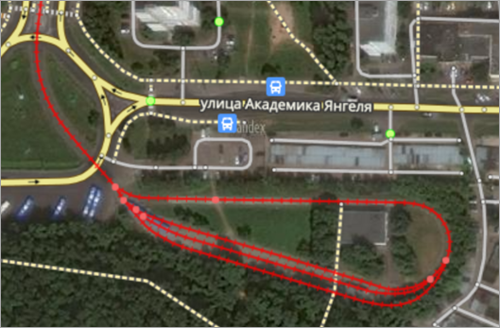
Passing sidings on single-track tram lines are drawn without restrictions:
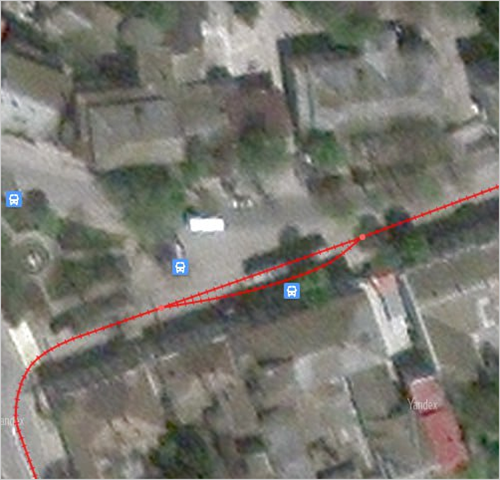
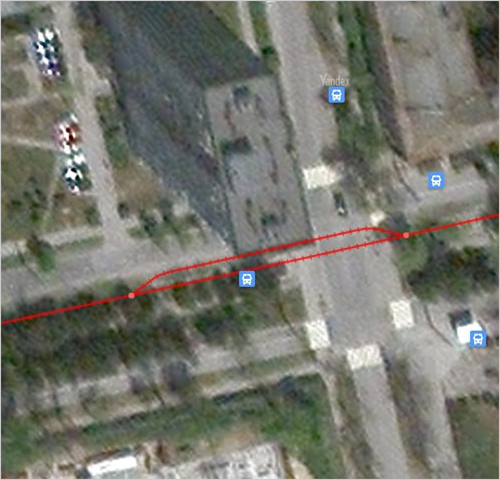
Tram tracks located on different sides of the same roadway are drawn using separate lines:
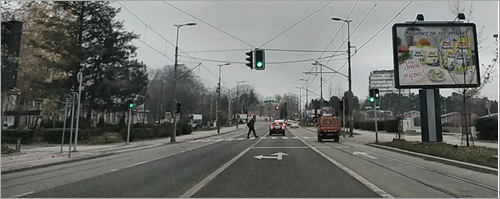
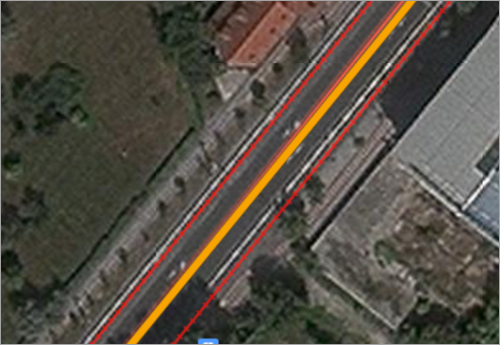
When mapping tram tracks, the point where they connect must match the location of switch mechanisms. If those mechanisms cannot be distinguished in the satellite photo, draw the connection point in the approximate place where they may be located.
If on double-track tram lines, switches on different tracks are located at a distance from each other, draw their point at a switch point (where a tram may diverge onto one of the two routes).
- 3.14.1.1.4
-
For the use of tram lines when drawing light rail items, see section 3.13.1.4.1. LRT Systems.
- 3.14.1.1.5
-
You can draw decommissioned tram line fragments using the “Tram tracks” type even if they're negligibly small.
Decorative tram line fragments that have never been used for tram traffic (for example, rails that are a monument or part of a monument) should not be drawn as tram tracks (you can add them to the map in the Locations layer).
3.14.1.2. Rules for drawing ground transport stops
This section contains rules for drawing stops for ground-level public transport in urban and suburban areas, as well as stops for inter-city buses if they are located outside of bus stations.
The rules for mapping bus stations, marinas, and stops on rapid transit lines are described in the corresponding sections.
Techniques for drawing and editing ground transport stops are similar to the techniques for drawing and editing all places items on YME (see these sections):
When drawing ground transport stops, you must adhere to the following rules:
- 3.14.1.2.1
-
You can draw transport stops on YME regardless of whether or not they are equipped for passengers to embark or disembark. When drawing stops, the actual location takes priority over the information provided in registries, websites, and so on.
If you don't know the actual location of a stop in a rural area, you should draw at least one stop for each rural settlement on or near a transport's route, even if no actual stops exist there (see section 3.14.1.2.1.2.2).
If the distance between stops is more than 30 meters, they are always drawn as standalone items. Nearby stops less than 30 meters apart should also be drawn as standalone items if they are separated by a road (class 1—9) or a difficult-to-pass roadblock (such as fences, buildings, or underpasses).
Otherwise, all nearby stops share one placemark.
Correct Incorrect 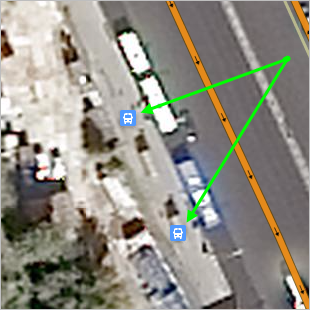
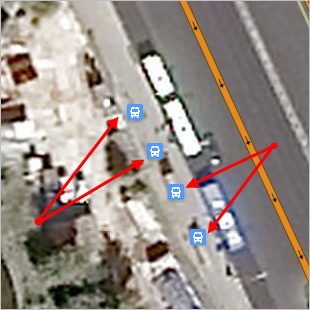
Correct Incorrect 

- 3.14.1.2.1.1. Equipped stops
-
Transport stop infrastructure includes the parts of the road that widen to accommodate bus stops and/or bus shelters.
All places with infrastructure for passengers to get on or off vehicles should be treated as items in the “Ground transport stop” category (i.e. not just actual stops, but also locations which are equipped for it even though no vehicles stop there at present).
The stop icon (place) should be placed approximately in the center of the passenger shelter rather than the actual location the transport stops at. If there is no passenger shelter, place the icon on an equipped waiting platform. If there is no equipped platform, place the icon on the edge of the traffic area or on the side of the road across the widening meant for public transport parking.
- 3.14.1.2.1.2. Unequipped stops
-
- 3.14.1.2.1.2.1
-
Draw unequipped stops if the following are true:
It has an official route sign with the name of the stop
The stop is included in official route schedules and that's where the transport actually stops.
The route section does not contain any equipped stops and transport only stops when prompted to. In this case you should put stops in the most popular locations for passengers to get on and off (e.g. major intersections, squares, close to shopping centers, etc.) and keep them at least 300 meters apart.
Put the placemark for an unequipped transport stop where the signage is located (if there is no signage, then on the curb.
- 3.14.1.2.1.2.2
- If a suburban route (or an inter-city route that acts as a suburban route or has suburban sections) passes through a locality without any equipped stops, and the closest equipped stop is at least 1 km away from the actual stop, a stop should be drawn for this locality.
If you don't know location of a bus stop, draw it near a large turn, intersection, store, or any other location with high passenger traffic.
If you're absolutely sure that a bus doesn't actually stop in the locality (despite register and bus station data saying otherwise), don't draw the stop there.
Note.Inter-city routes can act like suburban routes in cases when suburban service is canceled or hindered and passengers have to resort to inter-city transport to travel within the area.
- 3.14.1.2.1.3. Tram stops
-
Draw tram stops at the spot where passengers wait for the tram to arrive.
If passengers board the tram in the middle of the road, but the waiting area is located at the curb, then draw the stop at the curb.
If the waiting area for the tram is combined with the waiting area for other types of transport, then you do not need to draw a separate stop for the tram.
- 3.14.1.2.1.4. Other types of stops
-
You can also draw the following public transport stops:
For stops with no infrastructure: at intersections or at the exit lane from a highway near a locality (if there are no well-equipped stops nearby)
For bus stop areas: include them into the route (draw the stop around the area of a boarding platform's geometric center).
- 3.14.1.2.1.5 Don't draw stops
-
Don't draw public transport stops in cases where they only exist in a time-table, but there is no actual infrastructure in the area so that transportation vehicles skip them.
3.14.1.3. Rules for drawing bus stations
Techniques for drawing and editing bus stations are similar to the techniques for drawing and editing all places (see following sections):
- 3.14.1.3.1
-
Draw the buildings at bus stations using “Bus station” items.
Miscellaneous structures and buildings at bus stations that contain passenger infrastructure (waiting rooms, ticket counters) can also be mapped using this category.
“Do not draw” the following using the Bus station category:
Free-standing stops (including covered ones with waiting areas or final stops)
Boarding platforms and areas
Dispatch stations and other miscellaneous service buildings without passenger infrastructure.
If a bus station occupies part of a building that belongs to another organization (for example, a railway station or shopping center), then put the bus station placemark on the edge of the polygon for that building.